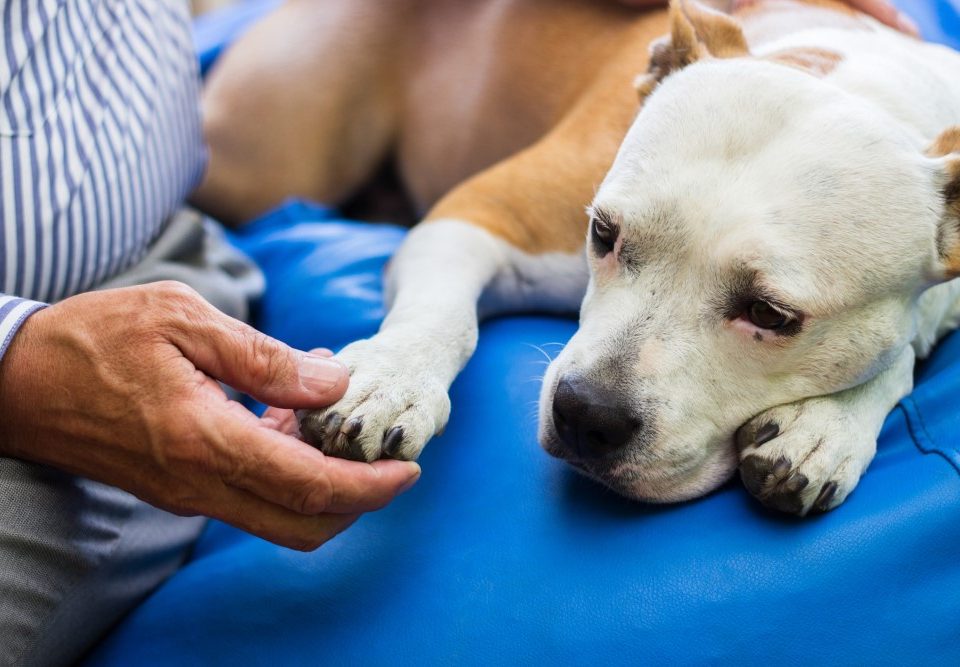
When to Put a Cat with FIV to Sleep?
July 18, 2023
Recognizing the Final Stages of Canine Diabetes
September 6, 2023
Table of Contents
- What is vestibular disease?
- What Causes Vestibular Disease in Dogs?
- Dog Breeds Prone to Vestibular Disease
- Vestibular Disease in Dogs – Symptoms
- How is Vestibular Disease in Dogs Diagnosed?
- Treatment
- Keeping Your Dog Comfortable
- How long can dogs live with vestibular disease
- Should you put to sleep a dog with vestibular disease?
- Caring at Home Gentle Euthanasia
- FAQs
- References and further reading
What is Vestibular Disease in Dogs?
The vestibular system is the biological apparatus that controls our dogs’ balance and movement. Sensors deep in the inner ear detect movements in the head in relation to the environment. The brain then processes this information and instructs the body to make tiny adjustments to maintain your dog’s balance. Vestibular disease or vestibular syndrome occurs when there is a problem in one of these two areas of balance control, the inner ear (peripheral vestibular disease) or the brain (central vestibular disease).
Vestibular disease is seen regularly by vets, but its actual frequency in the general dog population is low. In one study, just 0.08% of all dogs registered at a veterinary practice (including healthy dogs) were diagnosed with vestibular disease. Of these, only 14.1% had signs of central disease (brain involvement). Most dogs diagnosed with vestibular disease were older, with the average age at diagnosis being 12.7 years.
What Causes Vestibular Disease in Dogs?
Peripheral vestibular disease can be subdivided according to the underlying cause: inner ear disease (e.g., inflammation/otitis media, infections, tumours or polyps) or idiopathic vestibular disease. Idiopathic vestibular disease is the most common form and describes those cases where no particular underlying cause is found; the disease is spontaneous with no obvious trigger.
Your vet will try to differentiate peripheral vestibular disease from central disease, the latter being linked to inflammatory brain diseases, brain tumours, toxins and other conditions affecting the brain. Central vestibular disease is far less common and carries a worse prognosis.
Dog Breeds Prone to Vestibular Disease
According to recent research, vestibular disease is seen more commonly in the following dog breeds; French Bulldogs, Bulldogs, King Charles Spaniels, Springer Spaniels, Boxers, Cocker Spaniels, and Golden Retrievers. French bulldogs appear most at risk and are 9.3 times more likely to develop the disease than mixed-breed dogs. That said, vestibular disease can occur in any dog breed, including crossbreeds.
Vestibular Disease in Dogs – Symptoms
Some of the most common symptoms of idiopathic vestibular disease in dogs are:
- Lack of balance – ataxia (unsteady gait), falling to one side, unable to remain upright or stand
- Nystagmus – rapid and continual flicking of the eyes from side to side or in circles
- Vomiting due to dizziness
- Being unable to eat and drink
- Head tilt (one ear cocked) or turn (nose turned towards flank)
- Walking repeatedly in circles
However, no one symptom alone can diagnose vestibular disease definitively, and many other conditions cause similar signs. For those dogs with central vestibular disease, you might notice other changes, such as a depressed demeanour, confusion or seizures. The very sudden onset of vestibular disease can cause your dog to panic and move in a jerky manner, which might be misinterpreted as seizures in the initial stages.
How is Vestibular Disease in Dogs Diagnosed?
Idiopathic vestibular disease can be tricky to diagnose, as no specific underlying cause exists. Your vet will want to rule out different causes of vestibular syndrome and other conditions that have similar symptoms. For example, canine strokes (a blockage of blood vessels and therefore oxygen to the brain), bleeding in the brain (caused by clotting disorders or high blood pressure), brain or inner ear tumours, inner ear infections, inflammatory brain disease (such as encephalitis), hypothyroidism causing nerve inflammation and trauma – among other conditions.
Your vet will take a thorough clinical history, and discussing any possible toxicities, trauma, or other symptoms you have noticed over recent months is important. A thorough neurological examination will help decide whether the disease is peripheral or central – although this can be tricky to determine in some cases. If there are signs of ear infection, a swab might be collected for culture. Blood tests and blood pressure checks will help to rule out underlying or concurrent conditions that might complicate your dog’s recovery. In many cases, CT or MRI scans are recommended to rule out specific changes in the inner ear and brain. When this isn’t possible, monitoring your pet’s response to treatment in the first few days can give a clearer idea of the prognosis.
How is Vestibular Disease in Dogs Treated?
Idiopathic vestibular disease is usually self-limiting; in many cases, it will resolve on its own. In the meantime, the symptoms must be carefully managed, as it can be very unpleasant for your dog. Anti-sickness medications can help with vomiting, feelings of nausea and lack of appetite. Anti-anxiety medications and sedatives can help reduce your dog’s distress. An intravenous drip and feeding tube may be necessary if your dog cannot eat or drink. In fact, nursing is a huge part of your dog’s treatment plan; they may need hoists to walk, or, if they are bed-bound, regular turning and cleaning.
Antibiotics are only recommended where there is a known infection. Steroid treatment is often used when there is a diagnosis of inflammatory ear, brain or nerve disease or suspicion of this. In patients with idiopathic disease, there is no convincing evidence that steroids are beneficial, although in the absence of infection they are unlikely to do harm in the short term.
How to feed a dog with vestibular disease
Feeding a dog with vestibular disease can be challenging, and if you are struggling, call your veterinary team for advice. It can help to offer food and water close to where your dog is lying; bowls may need to be raised or lowered to ease access. You may need to prop your dog up on pillows or hand-feed them. Offer wet food or soften dry food with warm water or salt-free chicken broth to improve their hydration and aid digestion. Shaping tinned dog food into meatballs can make food easier for them to pick up and swallow. Something plain but tasty, such as steamed chicken breast, might entice your dog to eat initially, but avoid any new or rich food that might cause stomach issues.
Keeping Your Dog Comfortable
Adapting your home and routine is essential to ensure your dog is safe and comfortable once they leave the veterinary hospital. Their bed should be easy to climb into and should be in a place where you can regularly monitor them, including at night. Food and water should be placed close by and offered regularly by hand if their mobility is reduced.
Walking is challenging for these dogs, so provide non-slip mats on all smooth flooring, as your dog might feel unsteady and refuse to walk. Block stairways to prevent falls and guide or carry your dog up or down steps into the house. Puppy training pads are great for toileting, or you carry your pet outside until they can walk with assistance. Hoists and harnesses can help dogs regain their confidence walking and avoid falls. And finally, make sure that your pet is kept clean every time they go to the toilet. Bathing their bottom and applying barrier creams can greatly reduce the risk of skin infections or flystrike.
How long can dogs live with vestibular disease
In theory, dogs can survive indefinitely with idiopathic vestibular disease with the right treatment. However, as their guardians and carers, their long-term quality of life must be at the forefront of our decision.
The general rule for idiopathic vestibular disease is that dogs often improve substantially in the first 3-4 days and may continue to improve for approximately two weeks, occasionally longer. If your dog shows no improvement at all within the first few days, it is a concern. It might indicate a more serious underlying condition that has not been identified or is not responding to the current treatment. Or there may be permanent damage to the vestibular system.
Some dogs will make a partial recovery, but some symptoms remain life-long, such as a head tilt or an altered gait. It is important in these cases to determine the impact of this on your dog and whether they can cope with the new adjustments that are needed.
If your dog has vestibular disease symptoms that drastically impact their life, having an open conversation with your vet about possible prognosis is important. They will be able to guide you with expectations and timelines. In some cases, sadly, it has to be recognised that your dog may not get better.
Should you put to sleep a dog with vestibular disease?
Because vestibular disease has many causes, predicting how it will progress in the early stages can be hard. Some symptoms might be more concerning, particularly if there are signs of brain disease. Thankfully, despite its dramatic presentation, many dogs with idiopathic vestibular disease will recover, and many will show significant improvement within a few days. If your dog is not getting better within this time frame, they are deteriorating despite supportive treatment, or symptoms are very severe, it might be time to consider euthanasia.
Deciding to put a pet to sleep is difficult, and your vet, or our team of care coordinators, will help guide you through this. If your dog is elderly and their quality of life was poor before developing vestibular disease, some owners feel it is unfair to start treatment. Dogs with more serious symptoms need hospitalisation, which can be tricky for those prone to severe anxiety, and also very costly. In some circumstances, providing the level of care your dog needs is impossible. And, as a good outcome is never guaranteed, it may be kinder to put them to sleep.
Caring at Home Gentle Euthanasia
If your dog is at home with you, you may decide that peaceful in-home dog euthanasia in familiar surroundings would be better for them. For dogs that are struggling to stand and move, this means they can pass away peacefully with minimal stress and disruption. And for owners, home euthanasia offers a very private experience without the anxiety of moving your dog or being in a medical setting.
Discussing options and what is involved in home euthanasia is valuable. Our care team can talk to you about what to expect, any special wishes you might have and to reassure you about any worries. Having the option to say goodbye to your dog at home can, in many ways, make their last moments as positive and dignified as possible, surrounded by the family that loves them.
FAQs
How long can vestibular disease last in dogs?
A sudden bout of idiopathic vestibular disease usually improves dramatically in 3-4 days. If this does not happen, then there might be a more serious underlying condition causing the symptoms. Even with idiopathic vestibular disease, some dogs will take weeks or months to recover normal behaviour and mobility. Lasting effects may cause them to walk unsteadily or have a permanent head tilt or turn.
Is vestibular disease fatal?
Vestibular disease itself is rarely fatal, but the symptoms can be very severe, and without medical assistance, some dogs would not survive it, due to dehydration, malnutrition or other serious consequences. If vestibular disease is due to a brain condition or a serious infection, these less common variations might, sadly, lead to death. Fortunately, though, with the right care, many dogs make a good recovery.
What are the symptoms of vestibular disease in dogs?
The most common symptoms of vestibular disease relate to a lack of balance and dizziness, which can lead to falling or collapse, a head turn or tilt, vomiting and being unable to carry out normal basic functions like walking to the toilet or eating. The classic sign of vestibular disease is nystagmus, the constant and repeated flicking of the eyes back and forth.
Why does my dog keep showing signs of vestibular disease?
Unfortunately, some dogs are prone to vestibular disease. So, when they have had an episode, there is a high chance it may recur, even if your dog has fully recovered. Episodes can vary in severity and symptoms, so it is hard to predict when they might recur and how severe the next bout might be. If your dog has recurrent symptoms, always speak to your vet.
Can a dog get vestibular disease twice?
Vestibular disease can occur multiple times in one dog, so it is sensible to be prepared that it may happen more than once. For dogs with frequent or severe episodes, it can impact their quality of life, and some owners decide to put their dog to sleep to avoid this repeated distress. However, some dogs will only experience one episode in their lifetime, so if your dog does make a full recovery, they may go on to live a healthy and happy life with no future issues.
Is vestibular damage permanent?
In some dogs, symptoms of vestibular disease can be permanent. Often, they will improve to a point where your dog adapts and copes, but they may continue to have an odd gait or a head tilt which may look a little strange. As long as your dog is not distressed or in pain and is managing to function well and do the things they enjoy, then this is unlikely to be a problem. Speak to your vet about these symptoms and how you can make life easier for your dog at home.
Can I walk my dog with vestibular disease?
This is a great question to discuss with your vet at one of your dog’s check-ups. After all, every dog is different, as is every episode of vestibular disease. Some dogs can walk well with a slightly altered stride and head position, but this can cause falls and injuries for others. In the initial phase, strict rest is recommended to allow your dog some time to recover. Once their symptoms have improved and are more stable, assessing your dog in their own environment is best. See how they cope on a harness and lead, walking in the house or garden before you venture out. Harnesses with good chest support and handles on the back can help guide your dog when they first start walking or are a little unsteady; leads attached to collars should be avoided. It is also important to increase exercise very slowly, maybe just by 5-10 minutes per week.
References and further reading:
https://www.rvc.ac.uk/Media/Default/VetCompass/201103%20Vestibular%20infographic.pdf
https://www.vin.com/apputil/content/defaultadv1.aspx?id=5328290&pid=11349
Radulescu, S.M., Humm, K., Eramanis, L.M., et al. (2020). Vestibular disease in dogs under UK primary veterinary care: Epidemiology and clinical management. Journal of Veterinary Internal Medicine 34(5), 1993-2004




